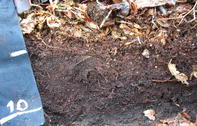It is vital that plant life develops in soil that contains enough organic matter. Organic matter will break down over time and supply the energy microorganisms need to further break down organic matter, which in the end will become the nutrients needed by plants to grow.

What is Organic Matter?
Organic matter is also referred to as soil carbon. Carbon is the main building block of all organic molecules and the amount of carbon in soil relates to the total amount of all the organic matter in the soil.
Organic matter in soil includes all plant residues and organisms living in the soil and consists of three distinctly different aspects - living organisms, fresh residues, and decomposed residues.
Living organisms should make up about 15% of the organic matter content of the soil and include microorganisms such as bacteria and fungi, as well as larger animals such as earthworms, insects, and moles.
Fresh residues are the dead organic matter that has not yet fully broken down (not yet composted) and consists of recently dead microorganisms, insects, plant material and fresh manures.
The well-decomposed organic material in soil is called humus. This is a thick brown or black substance that remains after most of the organic litter has decomposed. Humus binds soil particles together to form crumbs or aggregates. These aggregates create soil structure and enable the soil to retain moisture. Humus is the most stable organic molecule and is a source of slowly released carbon and energy.
The Benefits of Organic Matter
Agricultural soil should have between 1% to 6% organic matter. In South Africa, this figure can vary between 0.05% and 3 - 4%.
The more organic matter in the soil, the more food there is for microorganisms and the more nutrients will be released for plants. Organic matter breaks down by microorganisms through a process called composting.
In this breakdown process, the organic matter is used by these microorganisms as food and the nutrients in the organic matter is not yet available as nutrients for the plants. Only when well-composted organic matter is converted into humus does it become useful for plants. Humus holds onto nutrients, slowly releasing it in a form that plants can absorb through their roots.
When organic matter is broken down and composted in the soil, molecules are released from cells of fresh residues. These molecules include proteins, amino acids, sugars and starches and serve as food for other microorganisms in the soil.
These living microorganisms feed on plant matter and produce substances that bind soil particles together. These clumps of particles make up good soil structure and help to stabilise the soil aggregates. Organisms such as earthworms and some fungi also help to stabilise the soil’s structure. For example, by producing channels that allow water to infiltrate and, thereby, to improve the soil’s water-holding capacity and aeration.
How to Increase Organic Matter in Soil?

Increase organic matter in your soil by adding animal manure (not manure obtained from domestic animals such as dogs or cats), leaves, vegetable and fruit peels, grass, mulch, crop residues, composts and green manures.
Green manures can also be planted and incorporated by digging or ploughing it into the soil. Green manure is a crop that is sown and worked into the soil while still green. Green manures also add nitrogen and stimulate biological changes in the soil. Examples of green manure include legumes such as lucerne, cowpeas and clovers and non-legumes such as wheat, oats and rye. Mixtures of legumes and non-legumes are also used.
By Marinda Louw